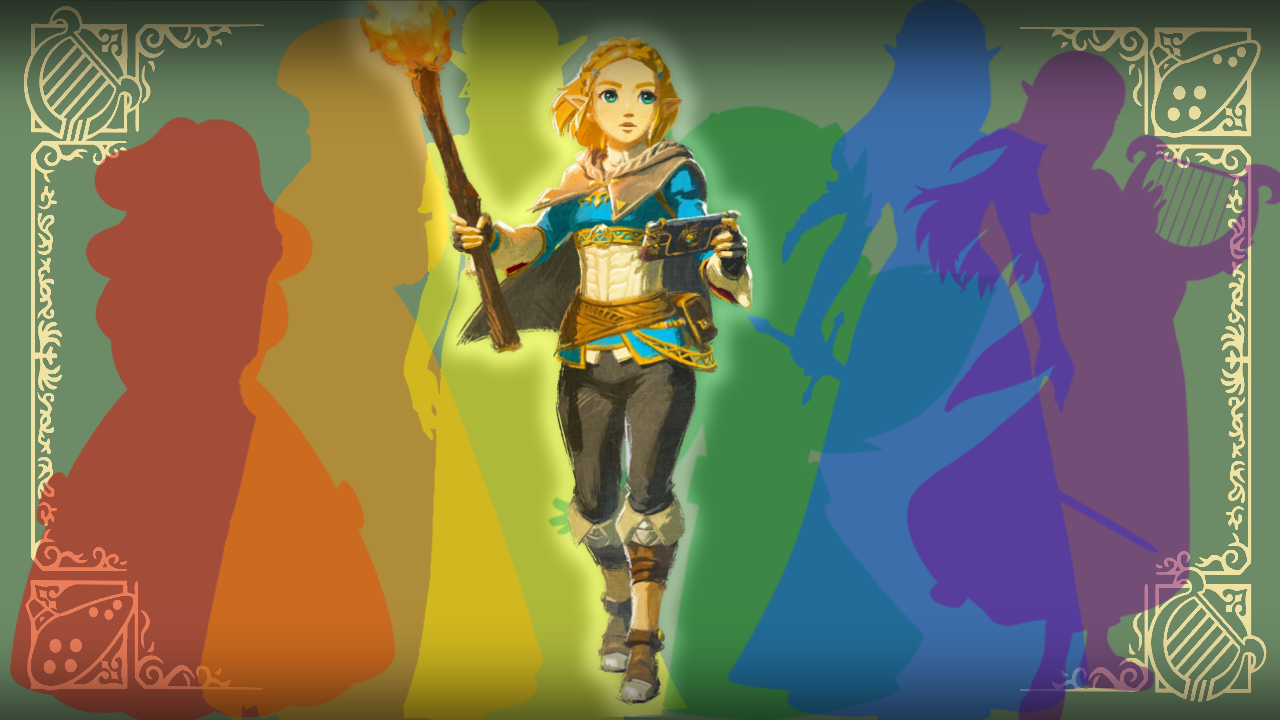Pride in Zelda: Ushering An Age Beyond Those of the “Princess Problem”
Posted on June 30 2023 by Emi Curtis

It’s almost July now, and Pride Month will soon be coming to an end. I’m determined to get one last little chat in before that though.
Two years ago, I wrote an editorial on the non-binary nature of Link. It was divisive to say the least, despite actually being relatively tame in terms of its ideas; ultimately, I think people just really didn’t like seeing Link in front of a non-binary flag. Today’s piece is in some ways a sequel to that editorial. But don’t fret; you don’t need to have read the prior editorial to understand what I’m saying here. Though, if you want a fun history lesson on why video games were marketed to boys for decades, I definitely recommend it.
No, today I’m not going to insinuate Link’s pronouns are they/them. Instead, I want to talk about gender roles and sociology, specifically in regards to the Zelda series.
A Tale as Old as Time
The story of the dashing hero or prince saving the princess is one of the oldest stories around. The likes of Disney and many others thrived off this idea for nearly a century. Wouldn’t you know that, in 1958, Disney made a deal with a small, little trading card printing company called Nintendo. Any given person likely holds the two media giants in completely different realms of their brain, but there was in fact a time when the two worked together quite directly.

As their work in the trading card business slowed and Nintendo went to work on clay shooting mechanisms and arcade machines, a weird moment of happenstance occurred. Originally conscripted to create a Popeye video game, Nintendo was caught off guard when the license for the property fell through.
Thankfully, a fledgling developer by the name of Shigeru Miyamoto quickly made the replacement characters of Mario, Pauline, and Donkey Kong, and inadvertently created one of the most iconic characters of the modern day. And wouldn’t you know it; besides King Kong, Miyamoto stated one of his other influences for the trio was the fairytale that would inspire Disney to make Beauty and the Beast in 1991.
Several years later, Miyamoto would find himself developing a game of unprecedented scale for Nintendo’s new home console, the Nintendo Family Computer, or Nintendo Entertainment System as we know it. Based on his youth, and the classic archetypal story of the daring hero saving the princess, Miyamoto created The Legend of Zelda.
The classic tropes of culture like good vs. evil and the prince saving the princess dominated the early years of Zelda‘s history. The original game, Adventure of Link, and A Link to the Past all featured some variation of Link saving the defenseless Zelda from the clutches of evil. The elements that form our sociological web are endemic and just about everywhere you can imagine. It is part of what makes us an elevated species in the first place. However, despite being an elevated species, we are no exception to evolution. Sure, we’re not developing different kinds of beaks in accordance with our diets, but our practices and culture change over time. Things that were once in chic fall out of favor for a more healthy and productive tomorrow. Many of the things that worked for our ancestors are absolutely unreasonable today.
Regarding Zelda, though, something started to shift around the 90’s. In the fourth game of the series, Link’s Awakening, we’d receive a bit of a different female deuteragonist opposite Link.
A New Legacy for a New Millennium
Marin, the pleasant islander who discovers Link washed up on Koholint Island, represents a bit of a shift for the series in terms of how it approaches women. While Marin does need to be rescued from a small incursion at one point, she spends most of the game relatively out of danger. In fact, she seems quite self-capable, happily joining Link on his journey for a time and getting into some interesting trouble depending on where you go. While certainly not the pinnacle of female empowerment, the shift would set the stage for an even more dramatic shift in the next game of the series... The Wand of Gamelon.
Just kidding; though it is amusing to note the role reversal of Zelda saving Link present in that game. No, we’re getting into The Legend of Zelda: Ocarina of Time.
Ocarina of Time was a game that in many ways bucked numerous conventions set by the series so far. Much of this had to do with the appointment of one Eiji Aonuma as the producer of the Zelda series going forward. As was discussed in my previous article, Aonuma has always been a forward-minded developer and has regularly showed little hesitation to break from convention. In interviews, he has always expressed an interest in creating things that would be enjoyed in the future as much as the present. This interest was of course the result of his origins as the son of a puppet maker and of him watching his father’s industry vanish with time, and the experience of applying those skills he learned to a modern world.
Going into the steps the game took, we’ll start just with Zelda’s role in the game. While relegated to her damsel status at the last second in a bizarre twist that still confuses me today, Zelda actually spends much of the game as her alter ego Sheik. The mysterious Sheik is a major driving force of the game, even taking much of the load off Link in guiding him places, rescuing Ruto, and defending Kakariko Village from Bongo Bongo. It’s an interesting subversion to have the princess you’ve been trying to rescue turn out to have been right by your side the entire time. Beyond just that, we actually see a number of other strong females in the game between the mysterious Impa, the ever-informative childhood friend Saria, and the aforementioned Sage of Water Ruto. I’d mention Nabooru too, but she barely says anything, all things considered.
 Though, speaking of Nabooru, she comes with the introduction of a race that might be one of the most fascinating inclusions within Ocarina of Time. This is of course the Gerudo, an (almost) all-women tribe of desert warriors.
Though, speaking of Nabooru, she comes with the introduction of a race that might be one of the most fascinating inclusions within Ocarina of Time. This is of course the Gerudo, an (almost) all-women tribe of desert warriors.
The Gerudo are, of course, not an original concept by any means. All-female nations of warriors go all the way back to the Isle of Lesbos from Greek myth and even the Island of Themyscira featured in the backstory of Wonder Woman. What makes the Gerudo unique is more their attitude than anything. At first, they serve almost an antagonistic role against Link, and, even after our hero earns their respect, they remain one of the more morally dubious allies in his quest. Even today, bandit clans in much of fiction very rarely feature a significant female presence amongst them, so an entire race of them is a very bold step. Majora’s Mask‘s pirate clan takes this even further by making them outright villains, but that’s not where we’re focused right now.
Ocarina of Time took dramatic steps to shift the narrative that the Zelda series’ foundation was built on, and that change has remained a major part of the series’ identity since. It’s a large part of why women like myself find themselves so attached to this series. While many series at the time were focused on very overt over-the-top themes of girl power, empowerment through sexualization, and female counterparts to male protagonists, Zelda‘s sense of female empowerment felt, by comparison, natural. It didn’t feel like an outright defiance of its world building thus far. The effect was applied across the board, creating powerful women of all manner of moral persuasions, and honestly, it didn’t really feel like a cheap marketing ploy to appeal to a new emerging demographic.
25 Years Later…
How does that feel? As of November of this year, Ocarina of Time was released 25 years ago. A quarter of century and so very much has changed since then. We’ve seen the birth and possibly death of the Zelda timeline, 15 mainline games have been released, and Princess Zelda has been everything from a pirate to a scholar to a ghost to a goddess. Yet, the more things change, the more they stay the same. Despite her playing all manner of roles in the Zelda series, in Breath of the Wild, the grand renewal of the series for a new era, its titular character has returned to her original role of being the object of Link’s rescue. Sure, she’s a lot more capable now, and infinitely more fleshed out as a character than her original three outings, but ultimately, her purpose in the story is to be rescued. To borrow a term from feminism, she was unequivocally “fridged”. Without spoiling the game at all, she does take a more active role in Tears of the Kingdom admittedly, but she once again exists primarily within memories within the past, unable to make a direct change in the plot’s direction until the final act of the game.
It’s not as though Nintendo has lost their sense of strong female figures though. Characters like Urbosa, Mipha, Riju, and Mineru harken to the figures we had in the likes of Saria, Sheik, Ruto, and Impa in the past. Even along the way, we had the likes Midna, Tetra, Fi, and even some more morally ambiguous female characters like Hilda in the series. So why exactly has the so-called “Princess problem” returned after all this time? It’s difficult to say exactly. There is of course artistic license that can be credited to the writing team. If that’s the Zelda they want to depict, they’re welcome to it. I may not like it, but hey, it’s not my game. I think that isn’t really it though. Despite how many new places the princess has found herself, rescuing her has remained a hallmark of many of the Zelda games throughout time, almost to a comical degree.
Think back to the very point I made about Sheik in Ocarina of Time. For the vast majority of the runtime, Zelda as Sheik is performing acts almost as equally daring as Link. Yet, at the last moment, she returns to her true form and becomes well… completely useless. She has the power to open doors and can dramatically gasp, but that’s about it. Tetra is a natural at combat and kept her crew in line for years leading up to The Wind Waker, yet the moment she’s revealed as Zelda, it’s not long before she’s incapacitated and kidnapped. She gets points though for actually doing something in the final fight unlike Ocarina of Time Zelda. Princess Zelda in Twilight Princess barely even gets dialogue before just handing off her lifeforce to save Midna.
I think the reality of matters is that Zelda is trapped in her trope of being the princess who must be rescued. Even years of progress and attempts to give her agency and personality cannot fight the original role she was created for. So what exactly do we do?
Leaving the Princess in the Past

Recently, Zelda’s voice actor, Patricia Summersett, was misquoted in an interview. Through clever snipping, many news outlets honed in on a statement that seemingly had her confirming Link and Zelda were in a romantic relationship. However, the full quote was ostensibly not her doing this, but in fact a call for the very opposite.
“As a voice actor, looking at the overall relationship between Link and Zelda over the ages, I personally love the ambiguity and that if there is something there it’s, left to us. I guess in my own life, I can respect and celebrate relationships that aren’t conventional…
“It also dodges the ending, and you’re always wondering what may occur which keeps the relationship active. There’s a tension in that, and this defiance of a definition is something really nice. I always come back to that, and I really love it as both an actor and as a human. Those relationships are super important to portray too, and I think they’re the best relationships we have in life, whether it be friendship or something that doesn’t have to fit a definition. I know that [Link and Zelda] are in a relationship with each other, it’s active, there’s a lot of care and a lot of listening, and I just love that about it.”
Summersett’s actual point is the first step towards an age when Zelda can move past being the role of princess in need of rescuing that she’s been relegated to for more than a quarter of a century. The fact that so many outlets happily jumped on the false confirmation of Zelda’s relationship with Link is exactly the reason she is still rescued in all these games. The prince and the princess living happily ever after is the hallmark of this trope, and it is inherently rooted in a past steeped in a male-dominated culture.
 The non-conventional relationships that Summersett seeks to celebrate are exactly what hold the key to freeing Zelda from the chains that bind her down as a character. That’s not even a controversial thing to ask for. I’m not asking Zelda be lesbian, or Link be trans-masculine, or really anything that introduces an LGBTQI+ element to the series. I’m simply asking that Zelda be a person first and foremost. Not a princess, not Link’s lover, and certainly not a “prize” for winning the game. Just Zelda. She and Link just being friends who save the realm together is an incredible step in that direction. I really loved Summersett’s response here, and it was particularly what inspired me to write this piece.
The non-conventional relationships that Summersett seeks to celebrate are exactly what hold the key to freeing Zelda from the chains that bind her down as a character. That’s not even a controversial thing to ask for. I’m not asking Zelda be lesbian, or Link be trans-masculine, or really anything that introduces an LGBTQI+ element to the series. I’m simply asking that Zelda be a person first and foremost. Not a princess, not Link’s lover, and certainly not a “prize” for winning the game. Just Zelda. She and Link just being friends who save the realm together is an incredible step in that direction. I really loved Summersett’s response here, and it was particularly what inspired me to write this piece.
The changes needed to create a Zelda for a modern age aren’t sweeping, drastic things. I’ll happily write about those kinds of things as fun “what-if” experiments, but in terms of realistic asks for the team at Nintendo, it’s subtle, little things like this that make a big difference as time goes on. Between the ending of Tears of the Kingdom and Summersett’s own views as Zelda’s voice actor, I have high hopes for a future where we don’t need to point out that Zelda’s a princess and an era where she doesn’t need to be rescued.
This series has and always will mean a lot to me, especially as a woman looking for representation. The likes of Saria, Midna, and Tetra were inspirations to me growing up, and even Riju’s more recent arc has given me thoughts about myself even as an adult. I truly want the title character of the series to join that list.
Pride in Zelda is an ongoing yearly series in which we highlight the Legend of Zelda’s approaches to inclusivity, spotlight relevant characters, and speak with fans from marginalized communities. It is our desire that the series’ installments be received with open minds and expose readers to new perspectives. Be sure to check out our other 2023 Pride in Zelda article by Vitor Masano: Five Female Legend of Zelda Characters that Are Ultimate Gay Icons.

Emi Curtis is an associate editor with Zelda Dungeon, having originally joined the team in late 2020. She is a freelance artist, programmer, and streamer with a healthy love of both the creative and analytical. She can frequently be found playing RPGs and Adventure games, her favorite of which being The Wind Waker. She is also quite fond of playing Zelda Randomizers. Currently, she hosts a tabletop RPG series on Twitch and operates a freelance illustration business. She can be found on Twitter and Twitch as her VTuber alter-ego Gwen Myoty, creating nerdy artwork, dungeon mastering tabletop games, and playing RPGs.




